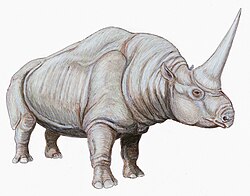| Anthracobune Temporal range: | |
|---|---|
 | |
| Life restoration | |
| Scientific classification | |
| Kingdom: | Animalia |
| Phylum: | Chordata |
| Class: | Mammalia |
| Family: | † Anthracobunidae |
| Genus: | † Anthracobune Pilgrim 1940 |
| Species [1] | |
| |
 | |
| The inferred range of Anthracobune | |
Anthracobune ("coal mound") is an extinct genus of stem perissodactyl from the middle Eocene of the Upper Kuldana Formation of Kohat, Punjab, Pakistan. [2]
The size of a small tapir, it lived in a marshy environment and fed on soft aquatic plants. It is the largest-known anthracobunid. This group was formerly classified with proboscideans.








